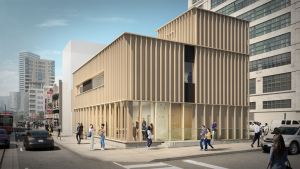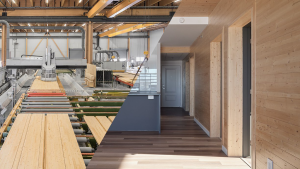Leading property insurers are cautioning project developers and builders concerning the risks unique to mass timber construction (MTC) that could affect insurability and premiums.
A 2021 white paper from Intact Insurance Specialty Solutions, the marketing brand for the insurance subsidiaries of Intact Insurance Group USA LLC, was not meant as a knock on wood so much as industry guidance.
“It is imperative for new building owners and general contractors to understand both the many advantages and disadvantages of mass timber construction. It’s easy for them to be swayed by the cost, speed, esthetic, and sustainability of this type of construction. However, there’s still research that needs to be done on the long-term effects of risk exposures before the industry chooses to go all in on mass timber. For the insurance industry, the potential damage to mass timber constructed buildings from smoke, fire and water must not be underestimated.”
Intact acknowledges while MTC may not carry the same exact fire risks associated with wood frame construction, it still has similar risks that need to be assessed and underwritten.
Some of the unique risks arise before any site work is underway. Since many MTC components are fabricated off-site, care must be taken during transportation to prevent damage. Similarly, site storage prior to component assembly must provide protection against the elements, issues to which MTC is far more sensitive than steel or concrete.
The paper also addresses worksite issues, for example, sparking from any welding or cutting.
“A mandatory hot work program should be implemented and enforced onsite.”
The larger the project, the more important are other measures that need to be taken.
“Site surveillance including watchman services, fire and intrusion detection alarm systems, and/or monitored cameras are much more important throughout all stages of construction than with projects that have non-combustible construction.”
As a result, Intact cautions project developers.
“Compared to concrete, steel or any type of non-combustible construction, insurance costs may be significantly higher during construction and upon completion for the life of the building.”
An even more comprehensive review of the risks unique to MTC comes from a white paper published last month by the RISCAuthority (Risk, Insight, Strategy and Control Authority) in the U.K., on behalf of the Fire Protection Association, the U.K.’s national fire safety organization. The paper was sponsored by 24 member insurance companies, including Chubb, Zurich, Travellers and Allianz.
RISC acknowledges the growing interest in MTC while seeking, “potential solutions where the provision of affordable insurance might be problematic.”
It says, “further research is needed on several areas related to massive timber construction” and advocates that “at least half of multi-storey buildings should be non-combustible materials.”
Not surprisingly, concerns include the spread of fire through a building constructed of mass timber components.
“A significant change that the use of modern building methods employing combustible materials has introduced is a third dominant potential route for fire spread in combustible voids between the occupied compartments that may run both laterally and vertically throughout the building, even connecting with the external envelope”
Likewise, water damage is identified as a major threat to MTC buildings.
“Water exposures may result from flood, weather ingress, short term failure of water bearing systems, long-term low-rate exposures, pooling, and during fire-fighting activities. All have the ability to impact the structural integrity, function and esthetics of timber through primary (glue denaturing, delamination, swelling, staining) and secondary (rot, moulds, fungus) mechanisms.”
Sudden fire exposure and longer term weakening due to water leave insurers pondering the question of structural collapse or “toppling.”
“Concrete and steel structures generally collapse to their footprint area but there is limited knowledge as to whether there is potential for massive timber structures to topple. Poor collapse behaviour could have significant consequence for scale of loss and life safety.”
Risk assessment is not a matter of regulations, the white paper cautions.
“For some (predominantly combustible) construction methods, compliance with building regulations alone might have little relevance to a building’s insurability”
John Bleasby is a Coldwater, Ont.-based freelance writer. Send comments and Climate and Construction column ideas to editor@dailycommercialnews.com.









Recent Comments
comments for this post are closed